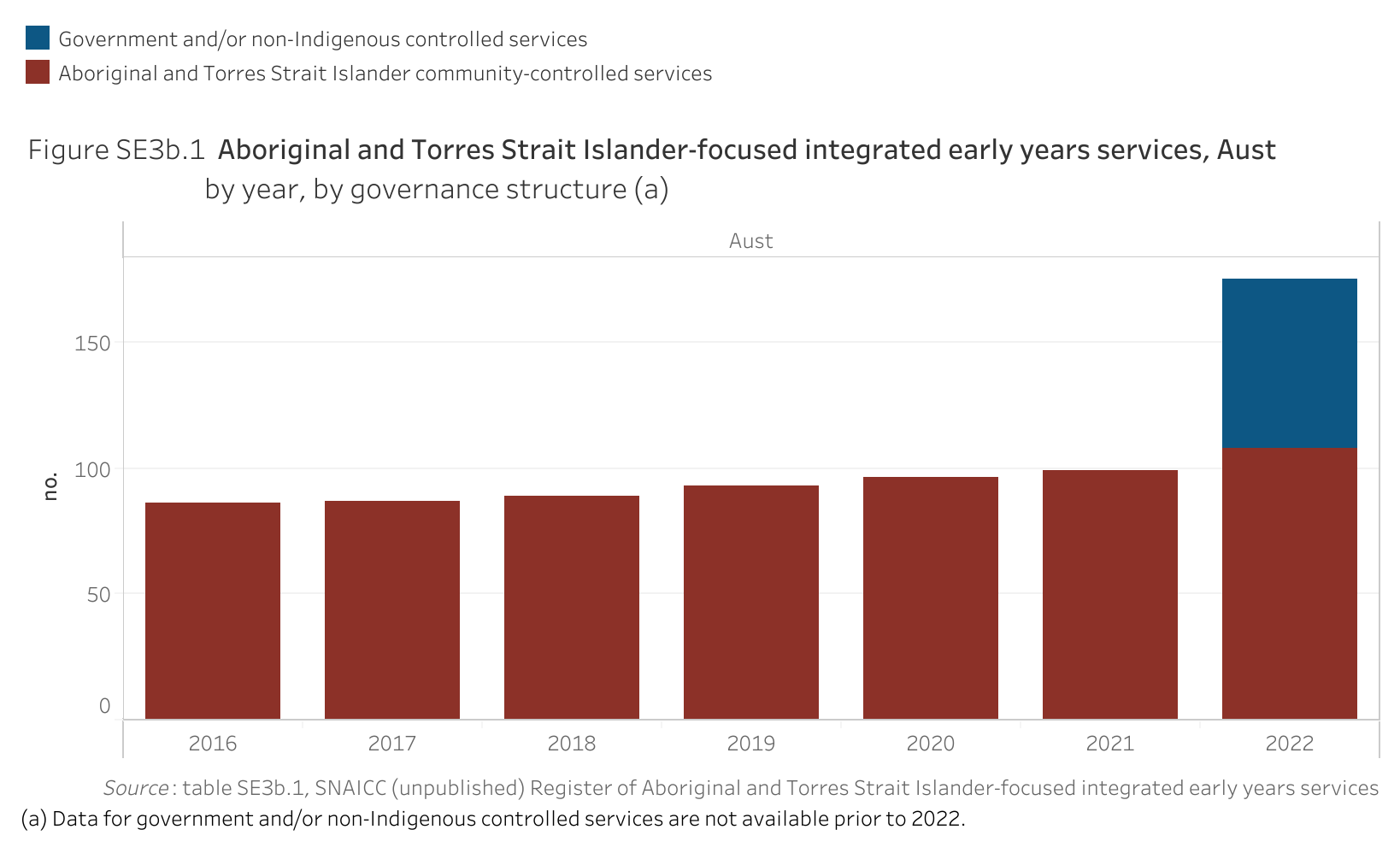Contextual information
Number of Aboriginal and Torres Strait Islander early childhood education and care service providers
Dashboard snapshot: The data below are the most recent at the time of preparing the July 2023 report. Please go to the dashboard to access the current data.
Measure
Number of Aboriginal and Torres Strait Islander-focused integrated early years services
Nationally in 2022, there were 175 Aboriginal and Torres Strait Islander-focused integrated early years services. Around 3 in 5 were Aboriginal and/or Torres Strait Islander community-controlled services (108 services) with the remainder government and/or non-Indigenous controlled services (67 services) (figure SE3b.1). Across jurisdictions, those with the majority of services that were Aboriginal and Torres Strait Islander community-controlled were NSW (45 out of 47), Victoria (11 out of 11), Queensland (26 out of 40) and WA (7 out of 10).
Nationally, the number of Aboriginal and Torres Strait Islander community-controlled early years services has increased each year since the baseline year of 2016, when there were 86 services.

| Description4 | 2016 | 2017 | 2018 | 2019 | 2020 | 2021 | 2022 |
|---|---|---|---|---|---|---|---|
| Government and/or non-Indigenous controlled services | na | na | na | na | na | na | 67 |
| Aboriginal and Torres Strait Islander community-controlled services | 86 | 87 | 89 | 93 | 96 | 99 | 108 |
na Not available.
Indicator data specifications
Related outcome: | Aboriginal and Torres Strait Islander children are engaged in high quality, culturally appropriate early childhood education in their early years. |
|---|---|
Related target: | By 2025, increase the proportion of Aboriginal and Torres Strait Islander children enrolled in Year Before Full time Schooling (YBFS) early childhood education to 95 per cent. |
Indicator: | Number of Aboriginal and Torres Strait Islander early childhood education and care service providers. |
Measure: | This measure is defined as: Numerator — the number of Aboriginal and Torres Strait Islander-focused integrated early years services, that are:
and is presented as a number. |
Indicator established: | National Agreement on Closing the Gap July 2020 |
Latest dashboard update for the indicator: | 15 June 2023 |
Indicator type: | Contextual information |
Interpretation of change: | A high or increasing number is desirable. |
Data source(s): | Name (numerator): Register of Aboriginal and Torres Strait Islander-focused integrated early years services. Frequency: Annual Documentation (links): |
Data provider: | Provider name: SNAICC – National Voice for Aboriginal and Torres Strait Islander Children (Aboriginal and Torres Strait Islander Corporation) Provider area: Social Policy and Research |
Baseline year: | 2016 |
Latest reporting period: | 2022 |
Disaggregations: | State and territory and Australia, by governance structure |
Computation: | Number Counting rules The number of Aboriginal and Torres Strait Islander early childhood education and care service providers includes all Aboriginal and Torres Strait Islander-focused integrated early years services nationally. These include Aboriginal and Torres Strait Islander child and family centres (ACFCs), multifunctional Aboriginal children’s services (MACS), Aboriginal and Torres Strait Islander preschool (kindergarten) services, and other Aboriginal and Torres Strait Islander-operated long day care centres. Early years services are counted separately for each location in which they operate. State and territory is based on the location of the service. Services are counted as at 1 August, annually. An ‘Aboriginal and/or Torres Strait Islander Community-Controlled Organisation’ is: a. incorporated under relevant legislation and not-for-profit b. controlled and operated by Aboriginal and/or Torres Strait Islander people c. connected to the community, or communities, in which they deliver the services d. governed by a majority Aboriginal and/or Torres Strait Islander governing body (National Agreement on Closing the Gap). ‘Government and/or non-Indigenous controlled’ Aboriginal and Torres Strait Islander-focused integrated early years services:
|
Data quality considerations: | Data are not comparable with Preschool Education, Australia, which counts services providing preschool programs only. Data are currently not available for government and/or non-Indigenous controlled services that do not receive funding via the Australian Government’s Child Care Subsidy System or Community Child Care Fund (CCCF or CCCF-Restricted) (such as state and territory government funded preschool services). Data for government and/or non-Indigenous controlled services are not available prior to 2022. |
Future reporting: | Additional disaggregations required for future reporting:
|
